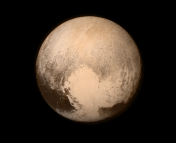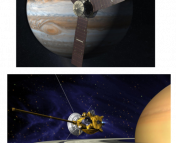In this series of posts, we sit down with a few of the keynote speakers of the 230th AAS meeting to learn more about them and their research. You can see a full schedule of their talks here!
From the extraordinary rings of Saturn to the frozen plains discovered in the heart of Pluto, Bonnie Buratti has explored them all. 
Buratti is the U.S project scientist for the European Space Agency’s Rosetta mission to comet 67P/Churyumov–Gerasimenko and is currently based in the planetary science division at NASA’s Jet Propulsion Laboratory in California. Rosetta is the theme for her #AAS230 LAD plenary talk “The Rosetta Mission to Comet 67P/ Churyumov‐Gerasimenko.”
Throughout her exciting career, Buratti has continuously upgraded her observational capabilities from the “little telescope” she owned when growing up, to the mighty Cassini spacecraft currently in orbit around Saturn. She has been involved in many great firsts, such as the first flybys of Neptune and Uranus for her PhD work on Voyager 1 and 2, and the more recent close-up observations of “it really is a planet” Pluto through involvement in the New Horizons mission. Buratti describes Pluto as a “fascinating object that we’ve never seen anything like before.” Images captured by New Horizons indicate that Pluto is unexpectedly exciting for a planet located at the edge of our Solar system. It has a spectacular geology, an entire weather system, and Buratti’s scientific highlight – active glaciers. This is the first time we’ve seen active glaciers on another body in our Solar system, and we found them on “little Pluto”.
The main mission in Buratti’s life is Cassini. Being in charge of designing observations for its icy moons means she has to convince fellow scientists which moon to target next, whilst also taking an active role in data analysis. After almost 20 years in space, Cassini is preparing for its “grand finale” by undertaking proximal orbits, which take this incredible spacecraft between the rings and planet itself. It’s a very exciting time to be involved with Cassini, but like most Buratti is “sad that it’s going to end in less than a year”. Involvement in such missions has allowed Buratti to study a variety of small bodies in the Solar System, her field of choice, by investigating their composition, evolution and generally how these small bodies tie into the evolution of the whole Solar System. For example, if a body has many craters, it may have survived collisions with many other objects; if a body’s composition is inconsistent with its location, that body must have travelled from elsewhere.
As a young scientist-to-be, Buratti always had this “insatiable drive for knowledge and discovery” that propelled her career forward. Besides pursuing this curiosity, her biggest piece of advice for students is “don’t give up” and “to be very persistent”. In her own words, “It never works out. If it had worked out, someone would have done it, and it would have been discovered already”. Buratti also highlighted the importance of collaborations and asking for help if you need it, because there are “all sorts of pitfalls, and you just have to press on”.
In her session, Buratti will discuss the discovery of organic molecules like nitrogen and amino acids on comet 67P. Many scientists believe comets originate in the cold realms of the outer solar system, where it’s easy for such molecules to form. Comets then travel towards the Sun and proceed to bombard planets like the Earth early in its history. Since the early Earth was too hot for complex organic molecules to form on it, this bombardment could explain how these molecules came to be on our planet. Evidence of organic molecules on comet 67P highlights how comets could be intricately tied in to the big question of how life formed. Don’t miss Buratti’s talk on June 6th, 8:30 am at #AAS230! The early bird gets the comet.





Trackbacks/Pingbacks